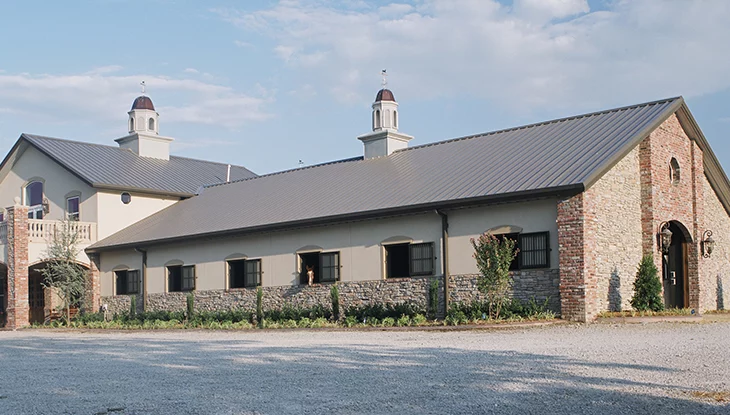Limited-Time Deal: Save 2% on MBCI Products
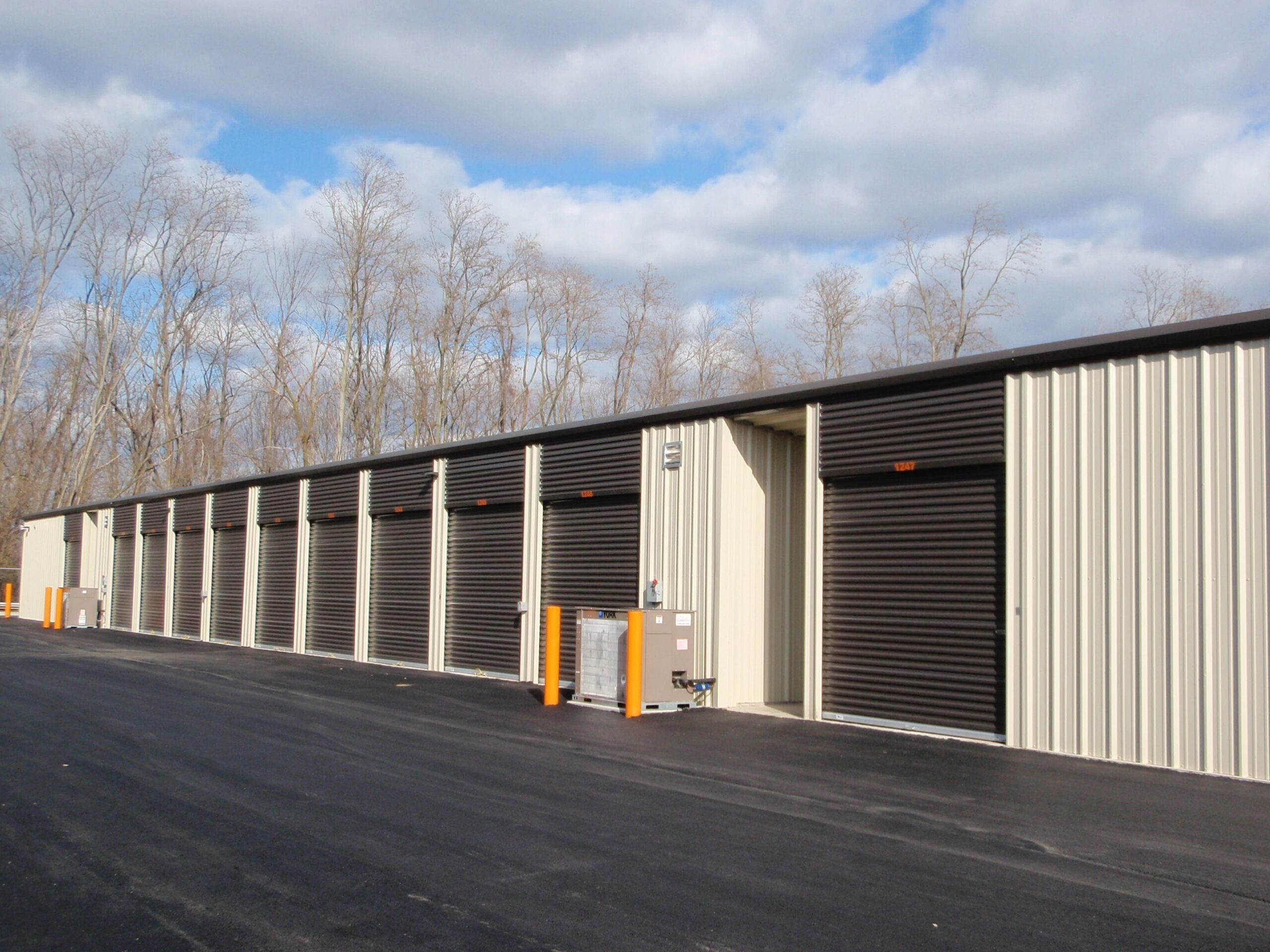

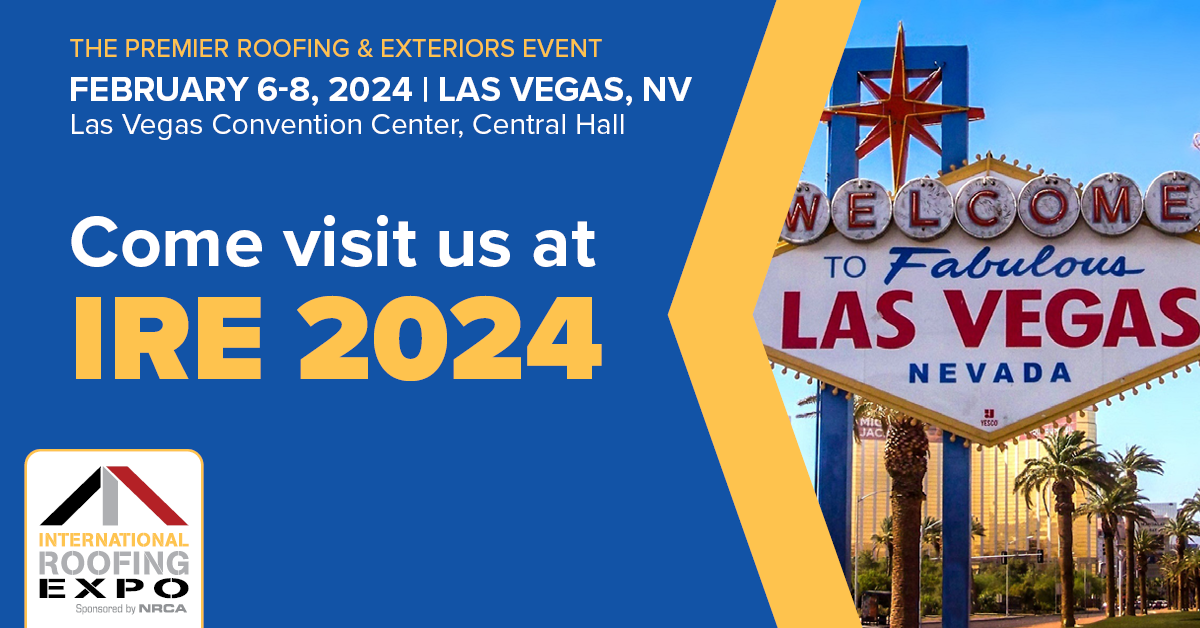
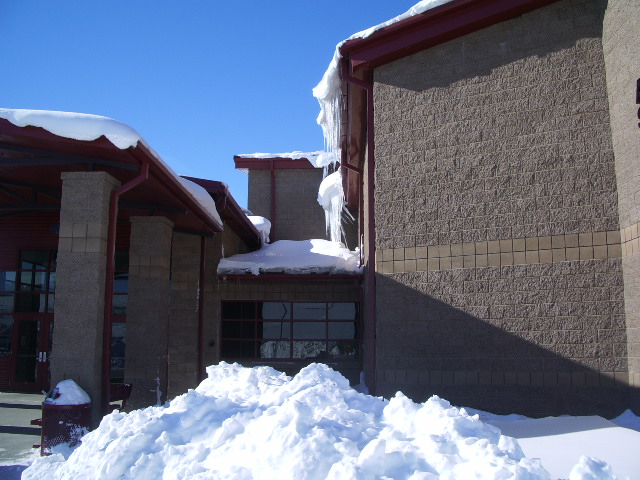

A meticulously designed and installed standing seam metal roof system provides the building owner with long-term dependability against harsh weather conditions. To do so, manufacturers must conduct a series of extreme weather or wind uplift test requirements for durability and protection against various weather situations involving high winds.
In the most severe weather conditions, metal roofs that have not been rigorously tested will succumb to wind pressure that can force panels to deflect. Causing seams to open and the panels to shift into failure mode at the corners and edge zones. Manufacturers will conduct roof uplift testing to ensure the typical corner and edge zone failure is passed.
The most reliable standing seam roof uplift test is the ASTM E 1592. It is the standard wind uplift test method for the structural performance of sheet metal roof and siding systems by uniform static air pressure differences. Below is a list of critical roof uplift standards we meet to provide our clients with the optimal metal roof design.
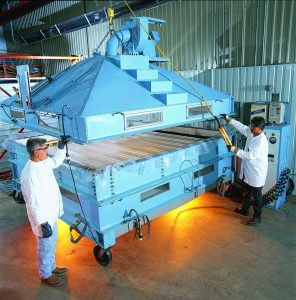
The UL 580 rating determines the uplift resistance of roof assemblies. The wind uplift test evaluates the roof panel, panel clips, fasteners, and substrate.
The UL 1897 wind uplift test is a continuation of UL 580 and is the standard for uplift tests for the roof covering systems. The purpose of this roof uplift standards test is to gain uplift resistance data for the panel assembly and evaluate the attachment of the roof covering systems to the roof decks.
FM 4471, Approval Standard for Class 1 Panel Roofs, states the requirements for meeting the criteria for fire, wind, foot traffic, and hail damage resistance.
This roof uplift standards test sets performance requirements for panel roofs, which includes all components necessary for installation of the panel roof assembly. This includes the potential for fire spread on the underside and exterior of the roof panel. It also measures the ability to resist simulated wind uplift resistance while maintaining adequate strength and durability.
This roof uplift test method provides a standard for structural performance under uniform static air pressure differences and is run to failure to find the ultimate uplift load capacity. This roof uplift standards test measures both panels and anchors. ASTM E 1592 is not a pass/fail test; it merely shows how a roof performs under uniform static load.
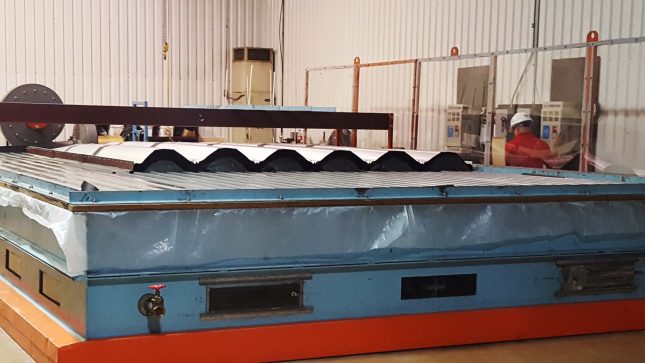
ASTM E 1592 was developed to account for the many complexities of evaluating uplift properties of metal roofing. The test method “provides a standard procedure to evaluate or confirm structural performance under uniform static air pressure difference. This procedure is intended to represent the effects of uniform loads on exterior building surface elements.” (https://www.astm.org/Standards/E1592.htm)
In conclusion, while all the standardized test protocols mentioned above were established to determine the uplift capacities of roof assemblies, only the ASTM E 1592 test is reliable enough for the design of standing seam roof panels. Among its key differentiators, the test considers the roof’s flexibility and changes in shape occurring under air pressure, and it measures both metal panels and their anchors.
The beauty of metal roof system skylights can be a real benefit to the aesthetic value of a metal building project. Beyond looks, though, the proven benefits of daylighting are many: building occupant satisfaction from natural lighting, mold, mildew growth prevention, and, of course, energy savings, to name a few. In fact, once the decision has been made to go with metal for the roofing material, a skylight is often a natural tie-in when it comes to sustainable design—for both form and function. To make the most of the design choice, there are a few key considerations to bear in mind during the specification and pre-installation phases of the process.
Common metal roofing skylight installation involves one of two types of skylights, Light Transmitting Panels (LTPs) and Curb Mount Skylights. Both metal roof system skylights supply natural light into the building and provide similar benefits.
LTPs, which are formed from a translucent material and come in many different panel profiles can be used not only in metal roofs but as an accessory for metal wall panels, too. One of the key benefits of LTPs is that the panel is formed so that it matches the configuration and characteristics of the system into which it is installed, and therefore can work seamlessly with specific metal roof systems.
Curbed (curb mount) skylights include a raised structure (“curb”) formed around the roof opening where the skylight will be attached. Curb skylights come in many shapes and styles.
In addition to the general “type” of the skylight, another consideration is selecting the best orientation for the skylight—which we will look at next.
Placement and orientation are some of the most crucial factors in getting the maximum benefit from metal roof system skylights. During the planning phase, determine the best location to achieve optimal light and avoid obstructions (such as HVAC, plumbing, electrical, and vent pipes) below the skylight. In terms of getting the most out of the skylight from an energy-savings standpoint, climate, and exposure are also key factors. For example, with southern exposure, skylights provide an excellent level of passive solar heat during the colder winter months, while keeping cooling costs down during the summer heat. On the other hand, a skylight with western exposure will increase cooling costs if the structure is in a warm climate.
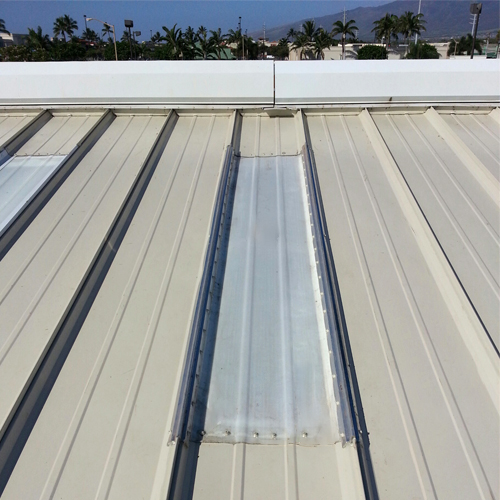
Metal roof skylight installation can be installed during or after the roof has been installed, but it is in the best interest of the project to plan for a skylight from the initial stages of the design phase to best accommodate and prepare for the addition of the skylight.
Skylights and LTPs should be guarded to protect from fall through the metal railing, nets or some other protection method. Last but certainly not least, it must be stated that it is the user’s responsibility to ensure that the installation and use of all light transmitting panels comply with State, Federal and OSHA regulations and laws, including, but not limited to, guarding all light transmitting panels with screens, fixed standard railings, or other acceptable safety controls that prevent fall-through.
For additional information about skylights for metal roofs, please contact MBCI at (877) 713-6224.
The substrate or substructure is a key part of the metal roofing system, which rests underneath the metal roof panels. The two types of substrates used with metal roofing systems are open framing and solid substrates (composite or plywood). Its two main functions are:
Substrates for metal roofing system considerations include the assurance of a structurally sound metal roofing base, knowing the type of underlayment required, and how that required support can vary depending upon the type of metal roofing product being utilized.
In its most basic terms, metal standing seam roof (SSR) and through-fastened roof panel systems can be supported on either open framing or solid substrates. The choice will often depend on the type of construction and the purpose of the building, including residential, commercial, industrial, and agricultural applications.
The two main types of substrates used with metal roofing systems are open framing and solid substrates (composite or plywood).
The open frame substrate uses wood or metal framing members (such as bar joists or min. 16-gauge purlins) to secure the metal roof panels. These members may be individual pieces of wood, formed steel, or truss-like members built from multiple individual pieces. Open-frame substrates for metal roofing systems should be used with structural-style panels in which the design can support the weight and can also span the dimensions of open areas.
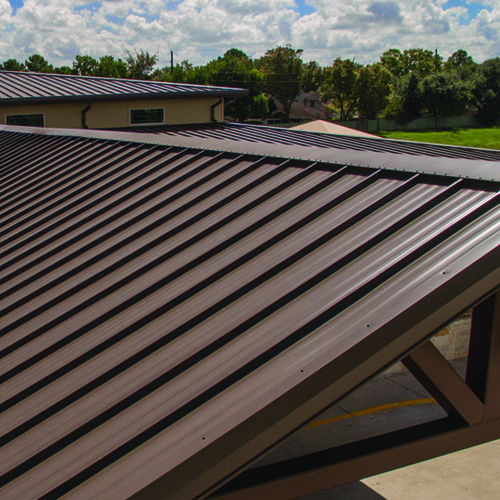
A solid deck substrate may consist of panels, solid sheets, or closely spaced deck members (made of wood, metal or composite materials) to which the roof membrane is applied.
It goes without saying that installers must follow OSHA practices and make sure to follow installation details of the manufacturer. Beyond this common-sense advice, there are other considerations to look at when matching substrate to a metal roof system, such as moisture control and acoustics. For instance, if you’re going over a plywood deck, you would always want to be sure you have a moisture barrier between the wood and the panel; metal decks should have a vapor barrier, and sound transfer through certain substrates could be an issue. It’s always wise to do your research–confirm with the manufacturer, check installation manuals, etc.
The main takeaway here is an awareness that depending on your project’s panel profile, you need to take steps to ensure you have the appropriate substrate. For detailed information on MBCI roof panels and substrates, view MBCI’s standing seam panels.
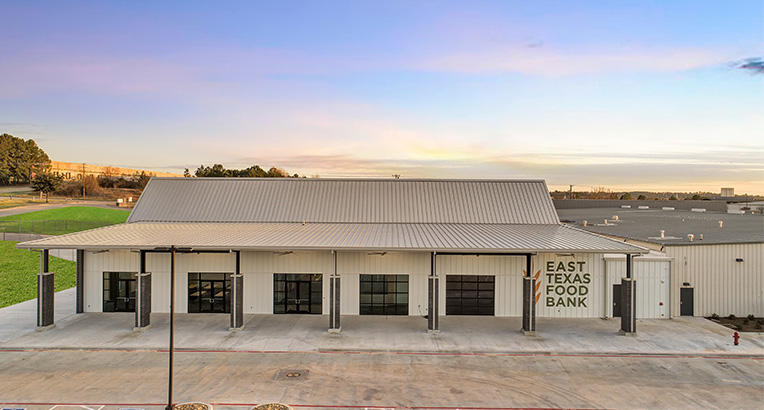
February 13, 2023
CARY, N.C.–(BUSINESS WIRE)–Cornerstone Building Brands, the largest manufacturer of exterior building products in North America, announced today a new partnership with D.I. Roof Seamers that will offer its MBCI customers greater access to the latest in seamer equipment for its industry-leading standing seam profiles. Through D.I. Roof Seamers, MBCI now offers customers better seaming equipment with the newest features and expertise direct from the seamer manufacturer.
D.I. Roof Seamers offers superior solutions so roofing contractors can install MBCI standing seam panels quickly and achieve weathertight seams. Their products are constructed from high-quality aircraft aluminum and are incredibly durable, backed by an in-depth quality control process. As a result of this partnership, effective immediately, MBCI will no longer stock, maintain or service seaming equipment.
“MBCI is known for building partnerships as strong as our products, and that extends to our industry partners like D.I. Roof Seamers,” said Jeff Holloway, Director of Field Services, Shelter Solutions, at Cornerstone Building Brands. “We’re excited to now offer our customers the best quality seaming equipment and access to seaming expertise direct from an industry-leading manufacturer like D.I.”
“D.I. Seamers is the leading manufacturer of seamer equipment, and MBCI is the leading brand of commercial roof and wall panels,” added Matt Cox, Vice President of Sales, MBCI. “This partnership provides our customers with access to high-quality products in both categories along with the benefit of expertise of both teams to ensure the best installation on their projects. And the best part is that the process doesn’t change for our customers. They can continue to depend on MBCI to be a single-source provider and coordinate the rentals on their behalf.”
About MBCI
Part of the Cornerstone Building Brands family, MBCI has partnered with our customers since 1976 to deliver high-quality metal building components backed by meaningful relationships and trusted performance. With our comprehensive portfolio and end-to-end expertise in building solutions, MBCI supports our customers throughout the project life cycle. For more information, visit mbci.com.
About Cornerstone Building Brands
Cornerstone Building Brands is the largest manufacturer of exterior building products by sales for residential and low-rise non-residential buildings in North America. Headquartered in Cary, N.C., we serve residential and commercial customers across the new construction and repair and remodel markets. Our market-leading portfolio of products spans vinyl windows, vinyl siding, stone veneer, metal roofing, metal wall systems and metal accessories. Cornerstone Building Brands’ broad, multichannel distribution platform and expansive national footprint includes more than 20,000 employees at manufacturing, distribution and office locations throughout North America. Corporate stewardship and environmental, social and governance (ESG) responsibility are embedded in our culture. We are committed to contributing positively to the communities where we live, work and play. For more information, visit us at cornerstonebuildingbrands.com.
About D.I. Roof Seamers
D.I. Roof Seamers is the largest dedicated roof seamer manufacturer in the world. They offer seamers and hand tools for rental that fit virtually any standing seam roof panel profiles on the market.

